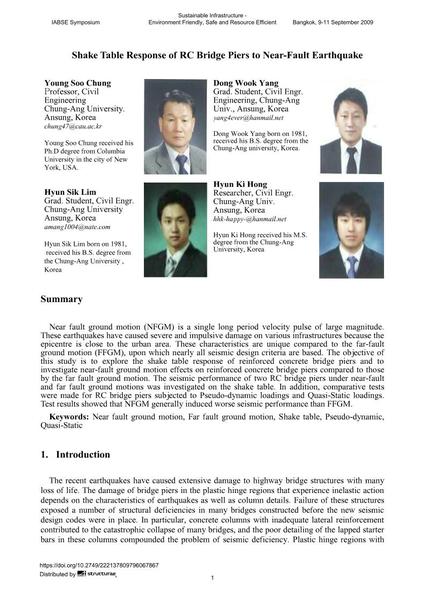Shake Table Response of RC Bridge Piers to Near-Fault Earthquake

|
|
|||||||||||
Bibliographic Details
| Author(s): |
Young Soo Chung
Dong Wook Yang Hyun Sik Lim Hyun Ki Hong |
||||
|---|---|---|---|---|---|
| Medium: | conference paper | ||||
| Language(s): | English | ||||
| Conference: | IABSE Symposium: Sustainable Infrastructure - Environment Friendly, Safe and Resource Efficient, Bangkok, Thailand, 9-11 September 2009 | ||||
| Published in: | IABSE Symposium Bangkok 2009 | ||||
|
|||||
| Page(s): | 66-75 | ||||
| Total no. of pages: | 8 | ||||
| Year: | 2009 | ||||
| DOI: | 10.2749/222137809796067867 | ||||
| Abstract: |
Near fault ground motion (NFGM) is a single long period velocity pulse of large magnitude. These earthquakes have caused severe and impulsive damage on various infrastructures because the epicentre is close to the urban area. These characteristics are unique compared to the far-fault ground motion (FFGM), upon which nearly all seismic design criteria are based. The objective of this study is to explore the shake table response of reinforced concrete bridge piers and to investigate near-fault ground motion effects on reinforced concrete bridge piers compared to those by the far fault ground motion. The seismic performance of two RC bridge piers under near-fault and far fault ground motions was investigated on the shake table. In addition, comparative tests were made for RC bridge piers subjected to Pseudo-dynamic loadings and Quasi-Static loadings. Test results showed that NFGM generally induced worse seismic performance than FFGM. |
||||
| Keywords: |
Quasi-static Near fault ground motion Far fault ground motion Shake table Pseudo-dynamic
|
||||
